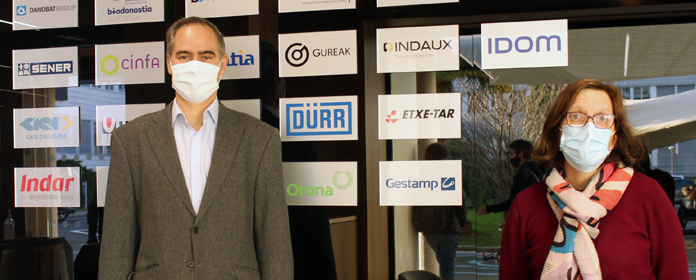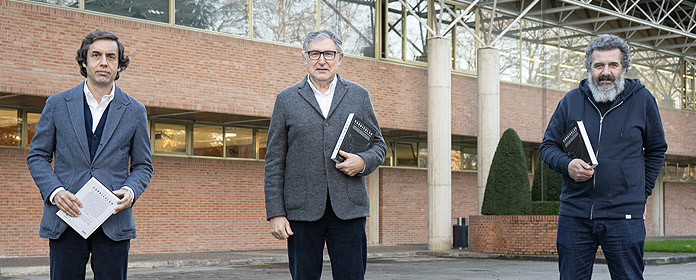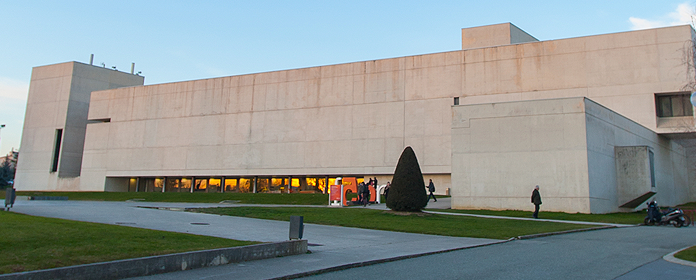"Sustainable architecture is in line with what society wants and needs."
Two internationally recognized architects explained their projects during the Sustainability Weeks

The fifth edition of the Sustainability Weeks, organized by the Master's Degree in design and management Environmental Buildings of the School of Architecture of the University of Navarra, concluded on March 16 after two weeks of classes, workshops and cultural visits.
As in previous editions, MDGAE students welcomed visiting students from Cardiff University and the Technical University of Dresden (Germany).
Sustainability Weeks took place between Monday, March 5 and Friday, March 16. During these two weeks, students had the opportunity to attend to lectures given by two architects, Byron Stigge and Peter Fisher.
These professionals, experts in sustainable architecture, explained the projects they have worked on and answered questions during the classes and workshops in which they participated as visiting professor.
Both agreed on the importance of implementing sustainability subjects in programs such as MDGAE, and emphasized how pleasantly surprised they had been to hear the "brilliant ideas" that the students had proposed during the classes.
In your opinion, do you think that governments, companies and society are aware of sustainability issues?
BYRON STIGGE (BS): Governments are very interested in sustainable architecture, many of the principles of Sustainability are: efficiency, social commitment, environmental issues... These are the same issues that concern society.
The goals of sustainability are the same as those of society itself. Sustainable architecture is in line with what people want and need.
PETER FISHER (PF): I think local governments are more aware than the central government. Are companies more aware? It depends on each company. There are many that are, I would highlight the progress that has been made especially in this area insurance companies. They have been aware of the impact of climate change, and have been able to see the risks that, as an insurance company, they could face.
Sometimes, in sustainability issues, more recognition is obtained from companies than from the central government.
What are the challenges facing this infrastructure subject in Europe or in countries on development?
BS: On the one hand, we find a high issue of old laws, even in Europe, that make it difficult to build new infrastructure, to develop new ideas. Sometimes you find that you have rules on energy issues that have been like that for 30 years. So, it is difficult to include new elements that this law does not contemplate, because at that time, they did not exist.
On the other hand, there are also challenges at subject economic. Currently, complex systems are used that increase budgets. Sustainable architecture uses simpler Structures , improving the economic estimation of project.
Likewise, it is also common to find challenge to work with other professional profiles, and to coordinate with them.
FP: Probably the ones that are the most difficult are the ones related to transportation and modernization. The biggest problem in European cities is that buildings are often old, how do you deal with the existing?
In terms of transportation, the infrastructure in old cities was not built with mass transportation in mind, or the need to transport masses of people through the center of medieval cities.
Not to mention the problem of climate change: how do we adapt to weather that is likely to be more unstable and warmer?
Why is it important to integrate sustainability issues into programs such as the MDGAE?
BS: It is important to teach sustainable architecture and engineering to architecture students and design, so that they can find a more global solution to the problems they may encounter when developing a project.
It is also essential to see others as collaborators, partners, not competitors. We need the architects to get involved with the structure, to build better parks, hydraulic systems, etc. They have the human point of view.
FP: It is extremely important. It raises awareness, and having more people leading on these issues. The potential solutions for a better world are better with an industry like ours. There's a lot of information missing on how to make the environment itself have less impact on itself. It's about thinking about building while consuming fewer resources.
What committee would you give to MDGAE students?
BS: Keep traveling. The more you learn, the more you will realize that there are many ways to solve the same problem.
FP: Continue to be optimistic. If you get involved in sustainability issues, and only see the negative side of the world, it can be depressing. Sustainability is not about addressing the negative issues that have been going on in the past, it is a vision of a better future society.
A second committee: Simplicity. Don't overthink it. The most sustainable buildings are the simplest.

▲ Peter Fisher during the Sustainability Weeks organized by MDGAE.




